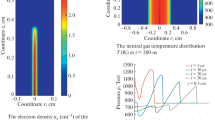Abstract
As a base for the theory of moving striations a partial integro-differential equation (26) is derived from the equations of continuity (1), (2), the Laplace-Poisson equation (3) and relation (4) between the electric field and the temperature of the electrons. Apart from the processes necessary for the actual formation of striations according to [1] and for the amplification of the wave of stratification according to [2], the equation also includes the processes defining the Debye length of the electrons, the influence of the axial electric field and of its local deflections on the motion of current carriers and the direct influence of the deviations in concentration of the electrons on the rate of production of current carriers. In deriving the equation the main attention is paid to the physical sense of the mathematical operations applied. The general solution is found by the method of the two-sided Laplace transformation and is described by triple integral convolution (42).
Abstract
На основе уравнений н епрерывности (1), (2), уравн ения Лапласа-Пуассона (3) и с о отношения (4) между электрическим полем и температурой электронов выведено интегродифференциа льное уравнение (26). Кроме про цессов, необходимых д ля возникновения слоев, согласно [1], и для усиления волны расслоения, согласно [2], в уравнении учитывают ся процессы, определяющие дебаев скую длину электроно в, влияние аксиального электри ческого поля и его локальных отклон ений на движение носи телей заряда и прямое влиян ие отклонений концентрации электр онов на скорость возн икновения носителей заряда. При выводе уравнения подвижных слоев глав ное внимание обращае тся на физический смысл отд ельных операций. Общее решение провед ено методом двусторо ннего преобразования Лапл аса и описано тройной интегрально й складкой (42).
Similar content being viewed by others
References
Pekárek L., Krejčí V.: Czech. J. Phys.B 11 (1961), 729.
Pekárek L., Krejčí V.: Czech. J. Phys.B 12 (1962), 296.
Pekárek L.: Czech. J. Phys.7 (1957), 533.
Robertson H. S.: Phys. Rev.105 (1957), 368.
Čapnik J. M.: ŽETF34 (1958), 1496.
Nedospasov A. V.: ŽTF29 (1959), 1388.
Watanabe S., Oleson N. L.: Phys. Rev.99 (1955), 646.
Prudkovskaja O. L., Širokov M. F.: DAN SSSR112 (1957), 1023.
Wojaczek K.: Ann. Physik3 (1959), 37.
Klarfeld B. N.: ŽETF22 (1952), 66.
Pekárek L.: Известия АН ССС Р, сер. физ.,23 (1959), 1050.
Pekárek L., Krejčí V.: Proceedings of the Fifth International Conference on Ionization Phenomena in Gases, North-Holland Publishing Co., Munich 1961, 573.
Pekárek L., Novák M.: Czech. J. Phys.9 (1959), 401.
Pekárek L.: Czech. J. Phys.8 (1958), 743.
Pekárek L., Novák M.: Czech. J. Phys.9 (1959), 641.
Pekárek L.: Czech. J. Phys.B 12 (1962), 439.
Van der Pol B., Bremmer H.: Operational Calculus Based on Two-sided Laplace Integral, Cambridge University Press, Cambridge 1950.
Author information
Authors and Affiliations
Rights and permissions
About this article
Cite this article
Pekárek, L., Krejčí, V. Theory of moving striations in plasma of D-C discharge I. Basic equation and its general solution. Czech J Phys 12, 450–460 (1962). https://doi.org/10.1007/BF01688531
Received:
Issue Date:
DOI: https://doi.org/10.1007/BF01688531




